Your Horse Will Thank You: Driving Tips for Smoother Trailer Hauling
At last! The delivery driver has arrived with your shiny new horse trailer. Now, all you need to do is load up your horse and head off into the sunset. Right? Well… maybe not.
Many drivers are lacking key knowledge and skills they need to safely (and comfortably) haul their horses down the road. You might get away with driving unprepared, but your horse certainly won’t be happy about the ride.
And an unhappy horse is MUCH less likely to load up easily the next time adventure comes calling. (Come on… we’ve all been there!)
That’s why we’ve put together this article with the top things you need to know BEFORE you start driving with your horse and trailer. Some of the information will help you during the trailer buying process. It will help you choose the right type of trailer so you can create a comfortable environment for your animals.
Then, we’ll arm you with some driving tips that make sure you are making smart decisions once the trailer is behind you and all that lies ahead… is the open road and adventure!
Key #1: Choosing the Right Axle and Tire Combo
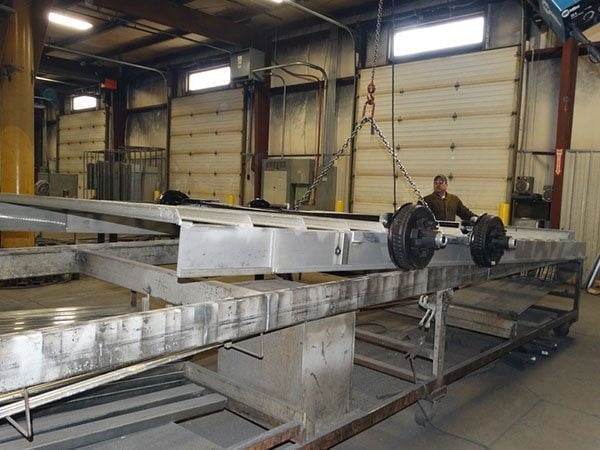
Now imagine your horse standing in a horse trailer. Driving down a bumpy road with the wrong type of trailer will cause your horse to feel every single bump and dip. He’ll feel that shock up through his legs and then throughout his whole body. Upon arrival, he’ll be stressed, sweaty, and likely exhausted.
The right type of trailer can provide shock absorption on these roadways to provide a smoother and more comfortable ride…more like that manicured highway. It will help your horse arrive fresh and energized rather than tired and anxious.
What type of axles does your horse trailer have?
The first ingredient in a smoother ride for your horse trailer is the wheel axles.
Brad Heath, owner of Double D Trailers, explained, “One thing we work hard on is to ensure the axles properly match the load being carried. In other words, don't use an axle that has too much capacity.”
“An axle with too much capacity is called a "stiff" suspension and will result in a very bumpy ride for the horse. It’s sort of like riding in a half ton truck empty, versus a dually truck that's empty….the dually "stiff" suspension can be very bumpy when the truck is not loaded.”
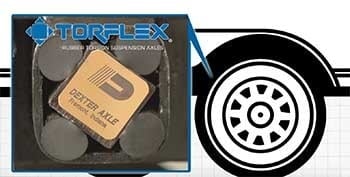
The actual cushioning effect is provided by a heat treated steel bar that is surrounded by four rubber cords. As the wheel moves over the ground, these cords cushion the bar and provide shock absorption.
The Torflex system is superior to other competitor systems that use only 3 rubber cords and a hollow interior bar. Torflex also provides improved suspension characteristics over leaf spring axles because they do not have metal-on-metal moving parts that wear out and they provide a quieter ride.
Are you using the right type of tire?
Next, your trailer needs to have the right type of tire to match your load. Tires come with different sizes (measured in inches) and load ratings. The side walls of the tires have varied stiffness levels depending on their rating.
You should not use a tire that’s severe “overkill” for the load requirements. In fact, it’s vitally important to have BOTH the axles and tires correctly match your trailer load.
Brad shared a story of a client many years ago who purchased a 2 horse slant gooseneck horse trailer. The trailer weighed 4,200 lbs approximately and required two 3,500 lb axles and 15” load range C or D tires.
“The guy INSISTED we use a 6,000lb axle rather than 3,500lb, and 16" E-rated tires,” Brad shared. “He said he had had too many bearing and tire failures and wanted ‘heavy duty’ suspension.”
We built the trailer, received full payment and the client came to pick it up from the factory.
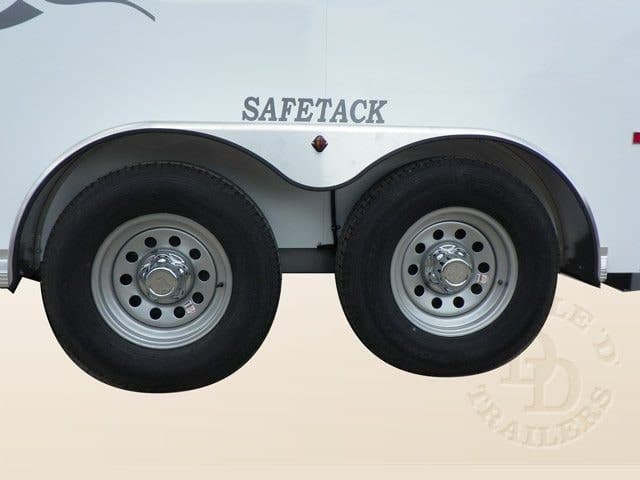
In another more recent instance, a Double D Trailers client in Florida ordered a SafeTack 2 horse gooseneck horse trailer with living quarters. The lady said her horses were both 1,500 lbs and she always hauled a full rack of hay and a fully stocked living quarters.
This client also insisted on a larger suspension system. Brad shared, “I warned her in writing ‘I recommend against this heavier suspension as, based on the load being hauled, it will transfer too much shock, vibration, and bounce back to your horse’s feet and legs’.”
Nevertheless, she wanted to push forward with the larger suspension and claimed she had previous experience with overloading axles. So Brad built the trailer and delivered.
Two months later Brad received a frantic email and phone call that while traveling with her horse he tried to jump through the drop down window! She was only hauling one horse, and he was 1,000 lbs….far from the 3,000 lbs of horse she planned to haul plus other gear.
“The trailer was very bouncy, and even my driver noted on delivery how stiff the suspension was!”
To solve the problem, Brad ended up shipping two 3,500 lb axles, and 15" size matching tires to a shop in Florida and had the entire suspension changed. She said immediately after picking up the trailer —even pulling out of the driveway— she could tell a noticeable difference.
“So these days, after two horrible experiences in building thousands of trailers, we do NOT allow customers to request "heavy duty" suspension.”
Key #2: Create a Horse Friendly Trailer Interior
We can talk all day about the value of choosing the right axles and tires. But if your horse is about to step onto a trailer and doesn’t like the look of the space… well… good luck!
That’s why it’s important to create a friendly interior for your horse. Some of these elements are things you can do with your existing trailer. And some of these are elements you can only really change by choosing the right trailer to purchase at the beginning of your journey.
Remember, horses are prey animals. They don’t like the idea of being trapped in a confined area where they will be vulnerable to predators. To them, a horse trailer, is really just a scary metal box.
Sure, they trust you as their owner, but trust has its limits. You can help your horse build confidence with the trailer by remembering their most basic needs: Space to move, air to breath, light to see, and safety from danger.
The Secret for a Rattle-Free Horse Trailer
Let’s start with safety from danger…
To a horse, a strange and constant noise represents a threat. The constant noise will make them nervous and cause the release of the stress hormone cortisol into their system. The result is a sweaty and nervous horse when you arrive at your destination!
Choosing the right axles and tires isn’t the only thing you need to consider when you’re trying to minimize rattles and noise in your trailer. The actual construction of your trailer’s outer metal skin plays a huge role too!
Many horse trailers are built with many round rivets holding on the metal siding. When the trailer is in motion, this metal-on-metal contact creates a lot of noise for your horse.
Plus, trailers with rivet construction are prone to rust since water is able to invade the spaces between the rivets and the trailer skin. The metal sidewalls tend to warp due to heat and this can result in a wavy look when viewed from an angle.
With modern technology, new rivet-free trailers are gaining huge popularity. With this type of design, the outer metal skin of your trailer is secured with a 3M chemical bonding system called VHB.
During construction, the inner and outer layers of metal are secured directly to the metal Z-Frame of the trailer. And don’t worry. The 3M VHB bonding is seriously strong stuff.
Best of all, it allows the metal in your trailer’s walls to expand and contract when the temperature changes WITHOUT the risks of noise, rust, or a wavy appearance.
Don't Bake Your Horse!
Sure, this one sounds silly, but you’d be amazed at how many trailer owners are exposing their prized animals to extreme temperatures each time they load up for a trip. And when we say extreme temperatures, we literally mean hot enough to fry an egg!
The secret to creating a safe interior temperature in your horse trailer comes down to the types of building materials used in its construction.
Many newer aluminum horse trailers look great, but there’s one big problem (well, maybe two big problems…)
First off, aluminum is an excellent conductor of heat. So, when the sun beats down on an aluminum horse trailer, that heat is transferred directly into the interior of the trailer. When a single layer of aluminum on the roof is used, there is nothing to protect your horses from the extreme temperatures.
Here at Double D Trailers we insulate the horse area of our trailers with an outer layer of aluminum and an inner layer of Galvalite metal surrounding a Z-Frame (zinc infused) chassis. Plus, we use a fiber composite roofing system. All of these elements work together to keep the interior temperature of the horse trailer nice and comfy.
The second problem with aluminum has to do with its strength. Have you ever crushed a soda can in your fist? Well, now imagine that same metal being used to protect your prized horses. Not good, right!
Create a Bright and Airy Interior
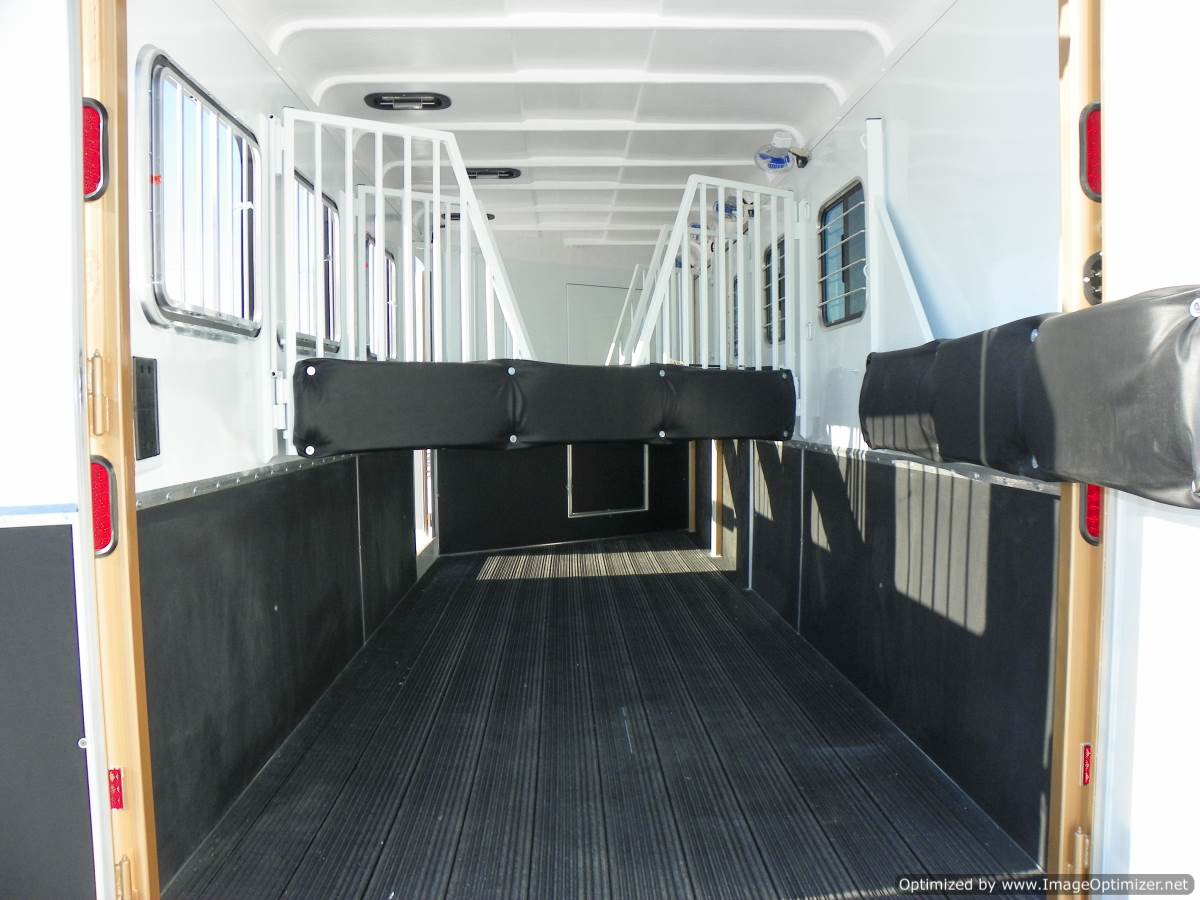
Then, large windows and tubular head dividers will allow your horses to see more of their surroundings. They’ll be able to see their travel buddy and generally feel more confident.
Overhead air vents work along with the large windows to create ventilation inside the trailer. This helps protect your horse from environmental fumes they may encounter while driving on the highway.
Give Your Horse Space to Move
Next, you’ll want to make sure your horse is in an appropriately sized horse trailer. No one likes feeling crammed into a space. So, if you have a large horse, make sure the trailer has enough space in the stall to accommodate them.
Here at Double D Trailers, we have horse trailers that can easily support a horse that is 15.3 to 16.0 hands. Then, if you have a larger 17.0+ hand horse, we have the ability to add custom footage on the width, height, and length of the trailer. Even the individual horse stalls can be made wider to match your horse breeds.
Horses are also much happier when they don’t have a manger in front of them. This is because they can lower their heads to cough out any particulates they inhale. A walk through design or a reverse load slant load horse trailer helps horses have room to move their heads.
Finally, think about the aspect of loading. Many traditional slant load horse trailers have a narrow rear door for loading and unloading. A stationary rear tack area makes it impossible to open the rear any wider for your animal.
A narrow doorway often makes horses nervous and increases the handler’s risk of being crushed if things go sideways. That’s why we always recommended our patented Safetack Horse Trailers.
These trailers have a rear tack area that swings out like a second door. This leaves a wide open area at the back of the trailer for loading and unloading. It’s much safer and gives you horses plenty of room to move during the loading or unloading process.
Pay Attention to the Flooring Type

Aluminum floors, popular in all-aluminum trailers, are the absolute worst choice of flooring material. They transfer a large amount of heat and road vibration into your horse’s legs causing fatigue and overheating.
In addition, aluminum floors require heavy rubber mats or protective coatings (like WERM or Polylast) as coverings. Rubber mats can be difficult to move and also hide dangerous metal corrosion that weakens the floor. Over time, you run the risk of complete floor failure, which can be disastrous to say the least.
We also do not recommend protective coatings like WERM, Polylast, or Rhino coatings because faulty application can allow moisture to invade the space between the lining and metal floor allowing for hidden corrosion to develop.
A much better choice for your horse trailer flooring material would be treated lumber because it transfers much less noise, heat, and vibration up from the road. They do still require rubber mats. At Double D Trailers, we use 2x8” pressure treated yellow pine for our trailers.
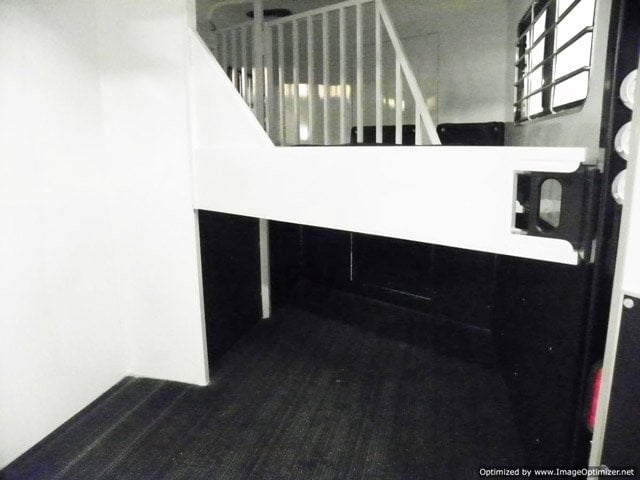
Finally, you may also choose a synthetic Rumber material to use in your horse trailer. Just like the treated lumber, this recycled material transfers less heat, noise, and vibration up from the road. Plus, it doesn’t require a rubber mat for covering! Your horse will arrive at your event with fresher legs and a calmer mind.
Once you’ve got the basics covered for the construction of your trailer, it’s time to move onto the last and most important key for smoother hauling with your horse trailer… safer driving
Key #3: Tips for Safe Driving With Your Horse Trailer
Hitching up your new trailer for the very first time can be an intimidating experience. It will quickly become clear that you are in a MUCH larger vehicle now traveling along the road with the lives of your family, your horses, and the other drivers in your sweaty palms.
Use these ten tips to make sure you are driving safely on the road with your horse trailer. Other drivers …and your horse… will thank you for it!
Check Your Horse Trailer and Tow Vehicle Before You Go
 1. Check that your tow vehicle, hitch, and trailer are well matched and in good working order.
1. Check that your tow vehicle, hitch, and trailer are well matched and in good working order.
It’s very important to have a properly matched trailer, tow vehicle and hitch. A low rated hitch with a heavy trailer is only asking for disaster.
Many people will ask what kind of cars can tow a horse trailer. In order to find the smallest tow vehicle that will work with your trailer, first learn your numbers. What is the weight of your trailer and its tongue weight?
Just to share an example, one of the lightest trailers offered by Double D Trailers was the Townsmand bumper pull model which weighed 2,500 lbs and had a tongue weight of 475 lbs when empty. Once loaded with a horse, tack, feed, and other gear, this trailer would weigh closer to 4,000 lbs. A second horse increases the total trailer weight even more -- to around 5,500 lbs.
Most cars are only rated to tow up to 4,000 lbs. Plus, you won’t find a sedan type car that can handle a tongue weight of 500 lbs on the back end of the car. So, even with this lightweight trailer, it would NOT be safe to haul this trailer with a car. Instead, you would want to upgrade to a larger tow vehicle with a higher towing capacity and tongue weight capacity.
After ensuring that your tow vehicle is safely matched to your trailer’s weight, check your truck and trailer for damage. You can be the safest driver in the world but that won’t keep you and your horse safe if your rig is a rusty bucket of bolts. Check for broken lights, a faulty emergency brake, damaged safety chains, weak flooring, rusted door latches, or anything else that would compromise the safety of you or your horse during travel.
2. Practice like your horse’s life depends on it.
Drive your trailer while it’s unloaded to get a feel for turning, backing, stopping and starting. While you’re at it, have a friend drive your trailer through a field with you in the back. Feeling the bumps from a horse’s point of view will give you more appreciation of how your driving can affect their ability to balance.
Backing is one particular skill that may need some extra practice. Brad Heath recommends, “Get in a large open area without any obstructions (or anyone looking) and take your time to practice. Most folks panic when it comes to backing simply because they have never taken the time to learn in a non-pressured environment.”
Here’s a little secret:
Put your hand on the bottom of the steering wheel to start. If you want the trailer to move to the left, move your hand to the left and vice versa. If you want to make sharp turns while backing, turn the steering wheel before you move the vehicle. If you want to make a more gradual turn, turn the steering while as the vehicle is moving.
Another important feature to practice is learning how to use your horse trailer’s brakes. Some light-duty horse trailers don’t have brakes, but usually trailer brakes are required if the gross vehicle weight (GVW) is over 3,000 lbs. These is especially important if you have a larger living quarters horse trailer.
Brakes on the trailer will help the entire rig come to a smooth stop without relying on just your tow vehicle’s braking ability. Remember, horse trailers are heavy – especially fully loaded – so extra braking power is a must!
Depending on your trailer, you might have low-tech hydraulic brakes or electric brakes. The hydraulic brakes will engage based on the resistance they feel from the towing vehicle. Electric brakes can be controlled by the driver from the cab of the truck.
Your trailer should also be equipped with a breakaway brake system powered by a 12-volt battery. These safety brakes will engage if the trailer ever comes unhitched from the tow vehicle to apply braking for a full 15 minutes after the breakaway.
How to Prepare Your Horse Trailer for Travel
3. Use smart loading practices.
Once you’re confident that your rig is in good shape, it is time to actually load up and set out. Most roads are crowned in the center so it’s a good idea to put the heaviest horse on the driver’s side of a straight load horse trailer. This will help balance the load for even driving. For a slant load trailer, it’s better to load the heaviest part of the load towards the front.
Some people wonder if it’s okay to load a horse wearing their tack. Well, the answer to that is “maybe.” If it’s a short ride and your horse is a calm traveler, then it might be okay for you to tack up before you go. This way, you can off load your horse, hop up, and be on your way quickly.
Make sure the saddle is tight enough that it won’t slip. It’s also a good idea to remove or tie up the stirrups so they don’t catch on anything. It’s safer to tie your horse in the trailer with a halter and put the bridle on once you arrive at your location for the same reason. You don’t want straps to get caught on any edges of the trailer. Just be aware, you’re risking damage to your equipment. Your horse may lean against an edge and scrape up the leather on your saddle.
Knowing how to properly load a horse onto your trailer is very important. Many trainers will suggest an approach and retreat strategy. You allow your horse the time to get closer and closer to the trailer each time until they feel comfortable stepping on. Even more important is having a trailer that your horse feels safe walking onto. That’s why we always suggest nervous horses be given the option of a walk-on-walk-off design. A Safetack trailer with a side loading ramp and door allows the horse to walk onto the trailer into a rear facing stall. Then, they can simply continue walking forward off the rear end of the trailer to off-load.
The dividers are designed in such a way that the horse can walk on and walk off without ever needing to back off the horse trailer. If you’re using the Safetack trailer with a front-facing orientation, then the horse loads from the back and walks off the side ramp. Or, if you choose not to include a side ramp, there’s even room to fully turn your horse around so they never need to back off.
One of the best features to keep your horse from backing off the trailer is the final rear divider. Oftentimes, trailers will use a basic butt bar or butt chain to keep the horse in their stall. These features can make offloading unsafe for the handler. Instead, a full divider behind the rear horse lets the handler walk up to the horse’s head to unclip their halter and attach a lead line. Then, when the rear divider is opened, the handler has better control of their horse to calming turn them around and walk off the trailer.
Regardless of how you choose to load and unload, make sure you load your trailer according to how it was designed. Orienting horses backwards in a trailer intended for forward facing horses will change the weight distribution and potentially cause problems.
After you’ve driven a hundred yards, jump out of your truck to make one final check of your trailer and horses. Anything you missed during your loading process will usually make itself apparent during a short drive down the lane.
4. Pack all safety gear for you, your horse, and your vehicle.
Driving a horse trailer is a good time to practice strong preparation.
Take along a charged cell phone and first aid kits for you and your horse. Keep a clearly-displayed list of emergency contacts. If you are incapacitated during an accident, the emergency responders can use this list to contact your veterinarian or friends to help attend to your horses. Finally, pack any road safety items you may need like a spare tire, jack, tire iron, chocks, emergency triangles, flashlight, and flares.
How to Safely Drive With Your Horse Trailer
5. Visibility: See and Be Seen.
It’s important to have full visibility while driving your horse trailer. Adjust your mirrors so you can see your trailer’s back end and check regularly while on the road. You might consider buying mirror extenders or “fish-eye” mirrors for your truck so you have the best view of what’s going on behind you.
Drive with your low-beams on even during the day so that other drivers can clearly see you. Double D Trailers are equipped with brake lights high up on the rear of the trailer so that more motorists can see when you are braking and have plenty of time to react.
6. On the Road: Safe Horse Trailer Driving 101.
The difference between driving a zippy sports car and a truck-trailer rig is immense. Allow extra stopping distance to account for the addition weight of your trailer pushing on the tow vehicle. Also, give yourself extra time to reach full speed when merging onto highways or pulling out onto roads to account for slower acceleration.
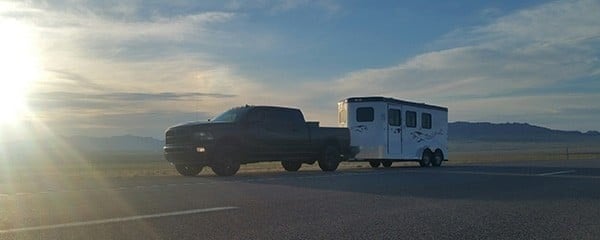
Practice good sense by traveling a safe speed for the current road conditions. Don’t be bullied into going faster by traffic behind you. If a long line develops, find a safe place to pull over so cars can pass. Brad added, “Horse trailers are equipped with trailer tires that carry a "ST" designation which stands for "special trailer". Most of those are rated at a maximum speed of 65 MPH. Keep speeds at 55 MPH on two lane roads and no more than 65 MPH on interstate travel.”
7. Know how to deal with trailer sway.
First off, a well-engineered trailer (with axles in the proper location) behind an adequately equipped tow vehicle should not sway to the point that correction is needed.
However, if you are in the unfortunate circumstance of trailer sway, lift your foot off the gas pedal to slow down to a safe speed so the sway stops. If the sway is severe (fishtailing) you need to use the hand brake/slider bar on your electronic brake control system inside your tow vehicle to slow down and bring your ride to a stop. The inertia of the tow vehicle trying to move forward against the brakes of the trailer trying to stop should help straighten the sway as you apply the brakes.
Brad added, “Resist the urge to step on the tow vehicle’s brakes….if you do this the inertia of the tow vehicle trying to stop with the trailer pushing forward will only increase the sway and could cause you to lose control.” Afterwards, immediately take action to correct the problem by finding a new trailer, sway bars, better weight distribution, larger tow vehicle, or by reconfiguring the load.
For Your Horse: How to Safely Drive a Horse Trailer
 8. Drive so your horse can balance.
8. Drive so your horse can balance.
Your horse will be much happier if you drive in a manner that allows him to maintain balance while the trailer is in motion. Give him time to prepare for stops and don’t acceleration too quickly. This way, he doesn’t get jostled or thrown against the interior dividers. After a slow turn, straighten out and give your horse a chance to rebalance before accelerating. Travel carefully over bumpy roads
9. Make regular stops for your horses to rest and rehydrate.
It’s important to give your horse breaks especially on very long trailer trips. You’ll want to take breaks every 2-3 hours so you can give your horse water, check them over for signs of distress and even refill their hay. These breaks give them a chance to rest their legs from the constant balancing they need to do while the trailer is in motion. If your trip is very long, you’ll want to plan overnight rest stops along the way. As long as they are fed and watered, a horse can safely handle 9 hours in a trailer in one day.
Dehydration is one of the biggest problems when you’re going on a long trip. Do your best to make your horse drink plenty of water before you leave. Also, do all you can to make sure your horse doesn’t overheat while on the road. This will cause extra sweating which leads to even more water loss. Once on the road, some horses won’t drink if the water smells different, so consider packing along some water from home or using things like apple juice to flavor the water. (The sugar in juice isn’t the best but it’s mostly important that your horse is hydrated.)
10. Be sure the interior of your trailer is comfortable for your horse.
Remember, the type of trailer you purchase can also make a big difference on the comfort of your horse during travel.
Use the three keys in this article to set yourself up for success. Make sure you’re using the right axle and tire combos to give your horse a comfortable ride. Choose a trailer interior that is both safe and horse friendly. Then, driving on the road in such a way that your horse is able to balance and relax until you get to your destination.
Driving a horse trailer on the road is not to be taken lightly. We hope that these 3 keys to smoother trailer driving set you well on your way to safe horse trailer driving for many years to come!
If you have any questions, be sure to reach out to Brad Heath. He can help you design a custom horse trailer that meets all of the safety criteria outlined in this article.

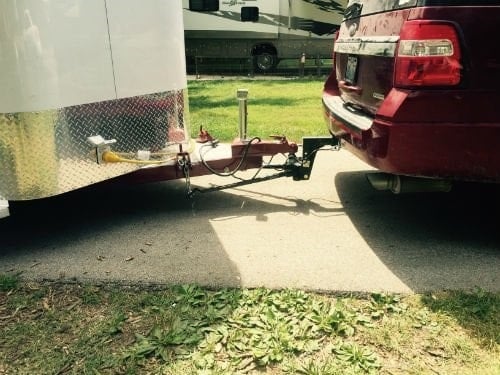 1. Check that your tow vehicle, hitch, and trailer are well matched and in good working order.
1. Check that your tow vehicle, hitch, and trailer are well matched and in good working order. 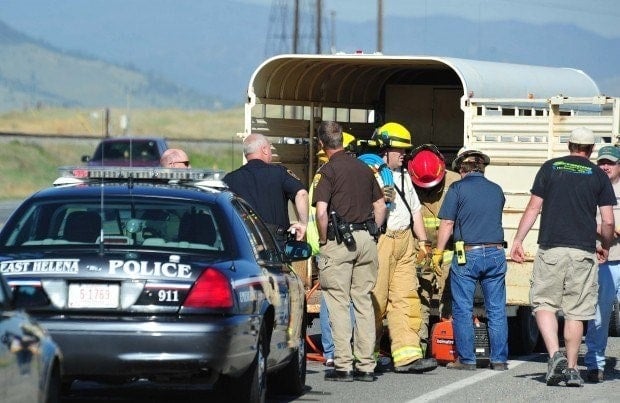
 8. Drive so your horse can balance.
8. Drive so your horse can balance. 